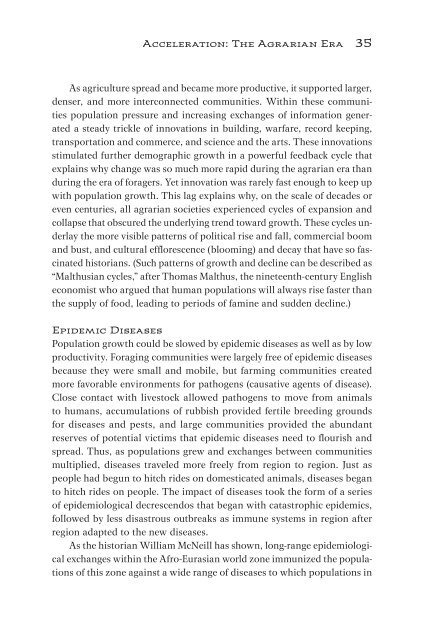This Fleeting World
This Fleeting World
This Fleeting World
Create successful ePaper yourself
Turn your PDF publications into a flip-book with our unique Google optimized e-Paper software.
Acceleration: The Agrarian Era 35<br />
As agriculture spread and became more productive, it supported larger,<br />
denser, and more interconnected communities. Within these communities<br />
population pressure and increasing exchanges of information generated<br />
a steady trickle of innovations in building, warfare, record keeping,<br />
transportation and commerce, and science and the arts. These innovations<br />
stimulated further demographic growth in a powerful feedback cycle that<br />
explains why change was so much more rapid during the agrarian era than<br />
during the era of foragers. Yet innovation was rarely fast enough to keep up<br />
with population growth. <strong>This</strong> lag explains why, on the scale of decades or<br />
even centuries, all agrarian societies experienced cycles of expansion and<br />
collapse that obscured the underlying trend toward growth. These cycles underlay<br />
the more visible patterns of political rise and fall, commercial boom<br />
and bust, and cultural efflorescence (blooming) and decay that have so fascinated<br />
historians. (Such patterns of growth and decline can be described as<br />
“Malthusian cycles,” after Thomas Malthus, the nineteenth-century English<br />
economist who argued that human populations will always rise faster than<br />
the supply of food, leading to periods of famine and sudden decline.)<br />
Epidemic Diseases<br />
Population growth could be slowed by epidemic diseases as well as by low<br />
productivity. Foraging communities were largely free of epidemic diseases<br />
because they were small and mobile, but farming communities created<br />
more favorable environments for pathogens (causative agents of disease).<br />
Close contact with livestock allowed pathogens to move from animals<br />
to humans, accumulations of rubbish provided fertile breeding grounds<br />
for diseases and pests, and large communities provided the abundant<br />
reserves of potential victims that epidemic diseases need to flourish and<br />
spread. Thus, as populations grew and exchanges between communities<br />
multiplied, diseases traveled more freely from region to region. Just as<br />
people had begun to hitch rides on domesticated animals, diseases began<br />
to hitch rides on people. The impact of diseases took the form of a series<br />
of epidemiological decrescendos that began with catastrophic epidemics,<br />
followed by less disastrous outbreaks as immune systems in region after<br />
region adapted to the new diseases.<br />
As the historian William McNeill has shown, long-range epidemiological<br />
exchanges within the Afro-Eurasian world zone immunized the populations<br />
of this zone against a wide range of diseases to which populations in


